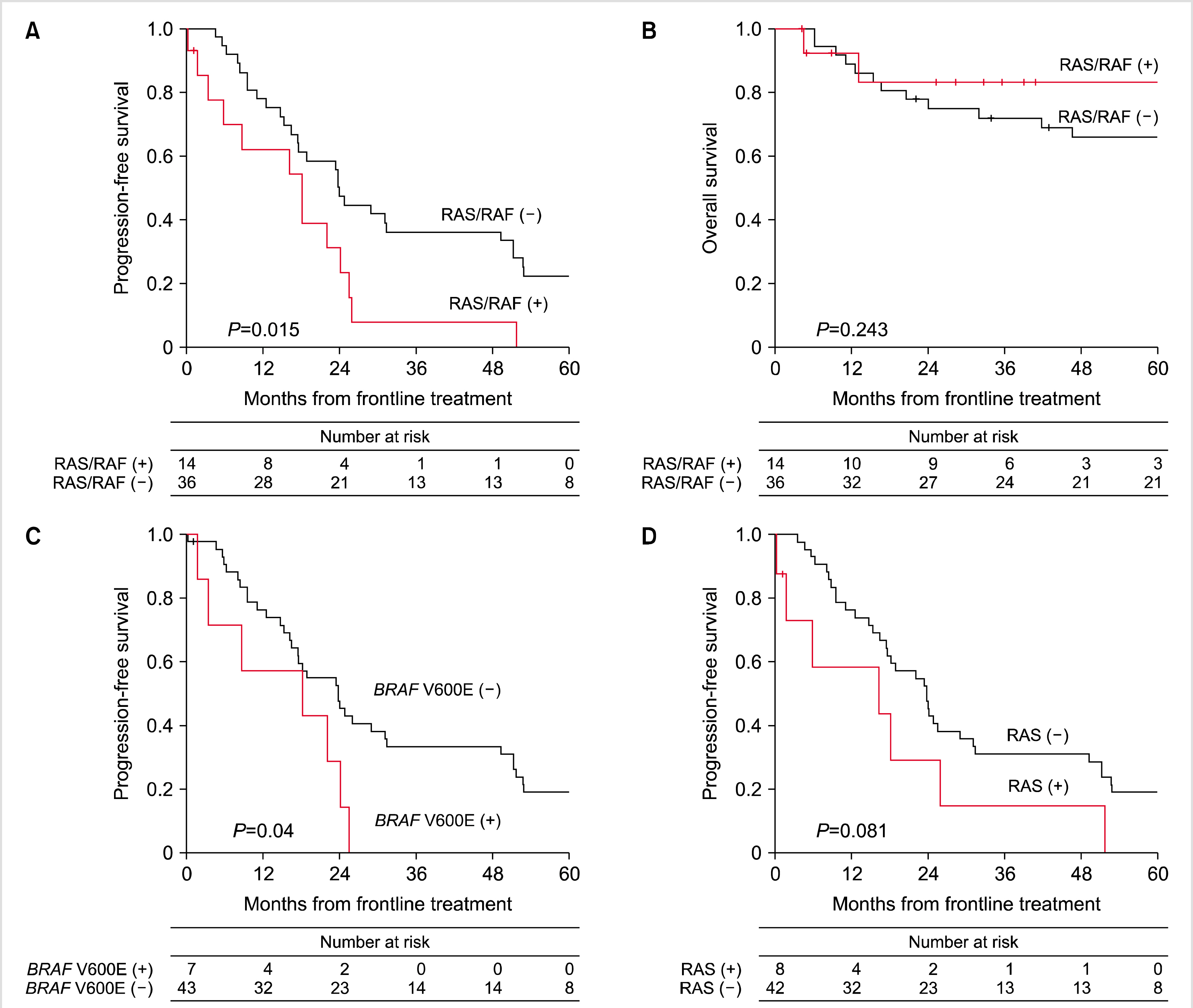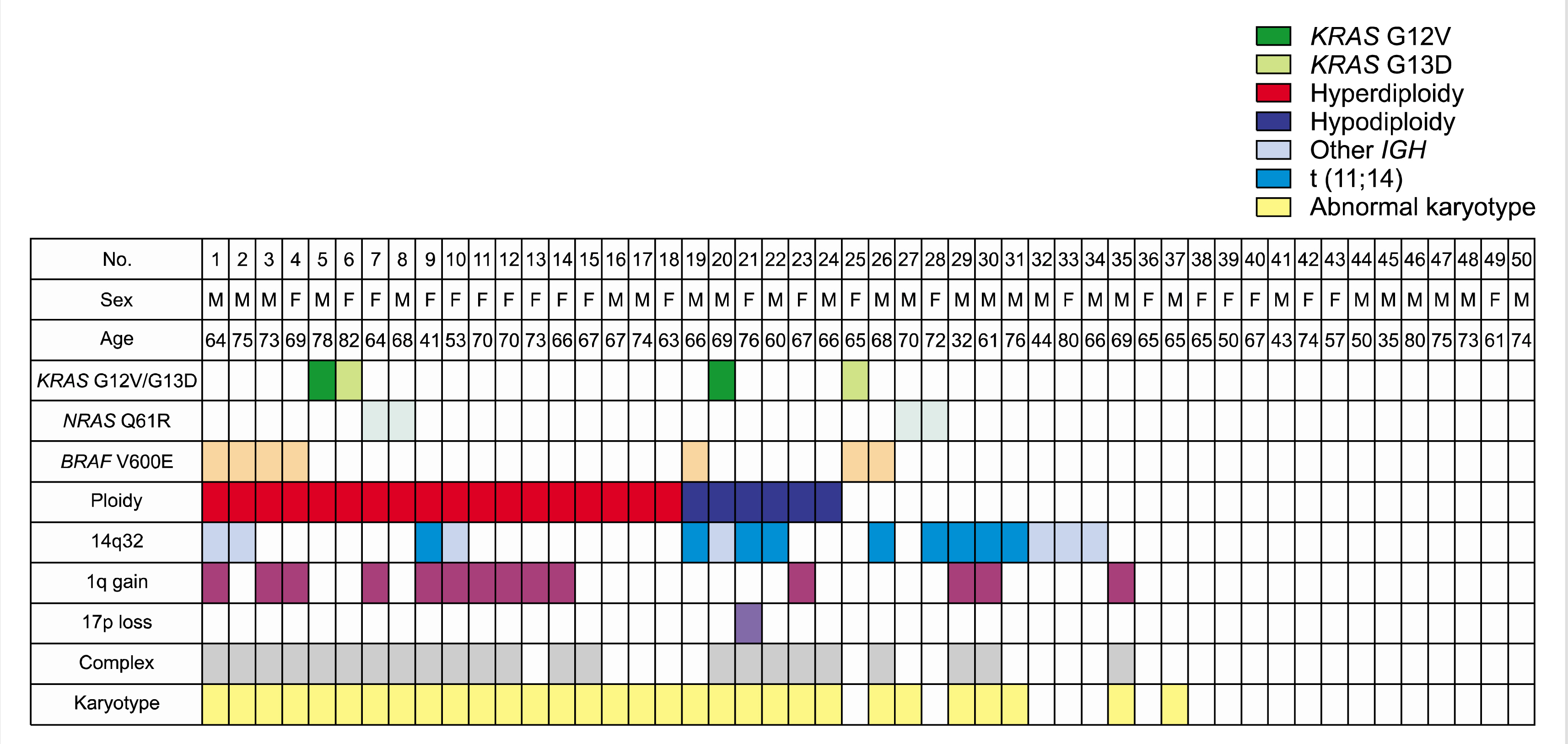1. Chng WJ, Dispenzieri A, Chim CS, et al. 2014; IMWG consensus on risk stratification in multiple myeloma. Leukemia. 28:269–77. DOI:
10.1038/leu.2013.247. PMID:
23974982.

2. Fonseca R, Bergsagel PL, Drach J, et al. 2009; International Myeloma Working Group molecular classification of multiple myeloma: spotlight review. Leukemia. 23:2210–21. DOI:
10.1038/leu.2009.174. PMID:
19798094. PMCID:
PMC2964268.

3. Bolli N, Avet-Loiseau H, Wedge DC, et al. 2014; Heterogeneity of genomic evolution and mutational profiles in multiple myeloma. Nat Commun. 5:2997. DOI:
10.1038/ncomms3997. PMID:
24429703. PMCID:
PMC3905727.

4. Chapman MA, Lawrence MS, Keats JJ, et al. 2011; Initial genome sequencing and analysis of multiple myeloma. Nature. 471:467–72. DOI:
10.1038/nature09837. PMID:
21430775. PMCID:
PMC3560292.
5. Smith D, Armenteros E, Percy L, et al. 2015; RAS mutation status and bortezomib therapy for relapsed multiple myeloma. Br J Haematol. 169:905–8. DOI:
10.1111/bjh.13258. PMID:
25580780.
8. Cheung CHY, Cheng CK, Lau KM, et al. 2018; Prevalence and clinicopathologic significance of BRAF V600E mutation in chinese multiple myeloma patients. Clin Lymphoma Myeloma Leuk. 18:e315–25. DOI:
10.1016/j.clml.2018.05.008. PMID:
29807803.
9. Lionetti M, Barbieri M, Todoerti K, et al. 2015; Molecular spectrum of BRAF, NRAS and KRAS gene mutations in plasma cell dyscrasias: implication for MEK-ERK pathway activation. Oncotarget. 6:24205–17. DOI:
10.18632/oncotarget.4434. PMID:
26090869. PMCID:
PMC4695180.

10. Lohr JG, Stojanov P, Carter SL, et al. 2014; Widespread genetic heterogeneity in multiple myeloma: implications for targeted therapy. Cancer Cell. 25:91–101. DOI:
10.1016/j.ccr.2013.12.015. PMID:
24434212. PMCID:
PMC4241387.
11. Davies H, Bignell GR, Cox C, et al. 2002; Mutations of the BRAF gene in human cancer. Nature. 417:949–54. DOI:
10.1038/nature00766. PMID:
12068308.
12. Walker BA, Boyle EM, Wardell CP, et al. 2015; Mutational spectrum, copy number changes, and outcome: results of a sequencing study of patients with newly diagnosed myeloma. J Clin Oncol. 33:3911–20. DOI:
10.1200/JCO.2014.59.1503. PMID:
26282654. PMCID:
PMC6485456.

14. Chng WJ, Gonzalez-Paz N, Price-Troska T, et al. 2008; Clinical and biological significance of RAS mutations in multiple myeloma. Leukemia. 22:2280–4. DOI:
10.1038/leu.2008.142. PMID:
18528420. PMCID:
PMC3864109.

15. Samatar AA, Poulikakos PI. 2014; Targeting RAS-ERK signalling in cancer: promises and challenges. Nat Rev Drug Discov. 13:928–42. DOI:
10.1038/nrd4281. PMID:
25435214.

17. Rajkumar SV, Dimopoulos MA, Palumbo A, et al. 2014; International Myeloma Working Group updated criteria for the diagnosis of multiple myeloma. Lancet Oncol. 15:e538–48. DOI:
10.1016/S1470-2045(14)70442-5. PMID:
25439696.
18. Jekarl DW, Min CK, Kwon A, et al. 2013; Impact of genetic abnormalities on the prognoses and clinical parameters of patients with multiple myeloma. Ann Lab Med. 33:248–54. DOI:
10.3343/alm.2013.33.4.248. PMID:
23826560. PMCID:
PMC3698302.

19. McGowan-Jordan J, Simons A, Schmid M, editors. 2016. ISCN 2016: an International System for Human Cytogenomic Nomenclature (2016). S. Karger;Basel, Switzerland: DOI:
10.1159/isbn.978-3-318-05979-3.
20. Mulligan G, Lichter DI, Di Bacco A, et al. 2014; Mutation of NRAS but not KRAS significantly reduces myeloma sensitivity to single-agent bortezomib therapy. Blood. 123:632–9. DOI:
10.1182/blood-2013-05-504340.

21. Park SJ, Sun JY, Hong K, et al. 2013; Application of BRAF, NRAS, KRAS mutations as markers for the detection of papillary thyroid cancer from FNAB specimens by pyrosequencing analysis. Clin Chem Lab Med. 51:1673–80. DOI:
10.1515/cclm-2012-0375. PMID:
23585181.

22. Bolli N, Biancon G, Moarii M, et al. 2018; Analysis of the genomic landscape of multiple myeloma highlights novel prognostic markers and disease subgroups. Leukemia. 32:2604–16. DOI:
10.1038/s41375-018-0037-9. PMID:
29789651. PMCID:
PMC6092251.

23. Rasmussen T, Kuehl M, Lodahl M, Johnsen HE, Dahl IM. 2005; Possible roles for activating RAS mutations in the MGUS to MM transition and in the intramedullary to extramedullary transition in some plasma cell tumors. Blood. 105:317–23. DOI:
10.1182/blood-2004-03-0833. PMID:
15339850.

25. Liu P, Leong T, Quam L, et al. 1996; Activating mutations of N- and K-ras in multiple myeloma show different clinical associations: analysis of the Eastern Cooperative Oncology Group Phase III Trial. Blood. 88:2699–706. DOI:
10.1182/blood.V88.7.2699.bloodjournal8872699. PMID:
8839865.

26. Gebauer N, Biersack H, Czerwinska AC, et al. 2016; Favorable prognostic impact of RAS mutation status in multiple myeloma treated with high-dose melphalan and autologous stem cell support in the era of novel agents: a single center perspective. Leuk Lymphoma. 57:226–9. DOI:
10.3109/10428194.2015.1046863. PMID:
25947035.
27. Wong KY, Yao Q, Yuan LQ, Li Z, Ma ESK, Chim CS. 2018; Frequent functional activation of RAS signalling not explained by RAS/RAF mutations in relapsed/refractory multiple myeloma. Sci Rep. 8:13522. DOI:
10.1038/s41598-018-31820-9.

29. Long GV, Menzies AM, Nagrial AM, et al. 2011; Prognostic and clinicopathologic associations of oncogenic BRAF in metastatic melanoma. J Clin Oncol. 29:1239–46. DOI:
10.1200/JCO.2010.32.4327. PMID:
21343559.

30. Chapman PB, Hauschild A, Robert C, et al. 2011; Improved survival with vemurafenib in melanoma with BRAF V600E mutation. N Engl J Med. 364:2507–16. DOI:
10.1056/NEJMoa1103782. PMID:
21639808. PMCID:
PMC3549296.
31. Hauschild A, Grob JJ, Demidov LV, et al. 2012; Dabrafenib in BRAF-mutated metastatic melanoma: a multicentre, open-label, phase 3 randomised controlled trial. Lancet. 380:358–65. DOI:
10.1016/S0140-6736(12)60868-X. PMID:
22735384.
32. Weißbach S, Heredia-Guerrero SC, Barnsteiner S, et al. 2020; Exon-4 mutations in KRAS affect MEK/ERK and PI3K/AKT signaling in human multiple myeloma cell lines. Cancers (Basel). 12:455. DOI:
10.3390/cancers12020455. PMID:
32079091. PMCID:
PMC7072554.

35. Kim K, Lee JH, Kim JS, et al. 2014; Clinical profiles of multiple myeloma in Asia-An Asian Myeloma Network study. Am J Hematol. 89:751–6. DOI:
10.1002/ajh.23731. PMID:
24723430.






 PDF
PDF Citation
Citation Print
Print



 XML Download
XML Download